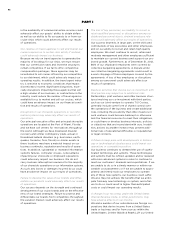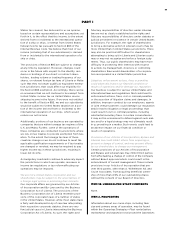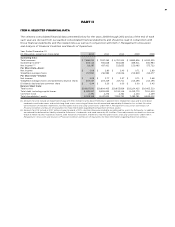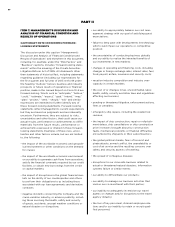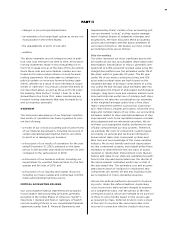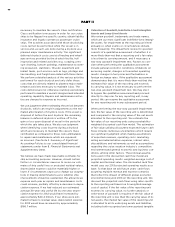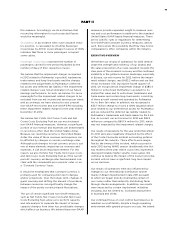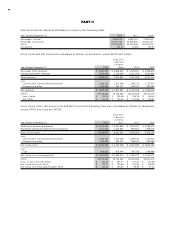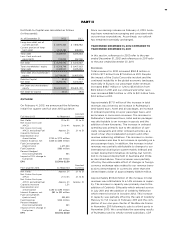Royal Caribbean Cruise Lines 2012 Annual Report Download - page 43
Download and view the complete annual report
Please find page 43 of the 2012 Royal Caribbean Cruise Lines annual report below. You can navigate through the pages in the report by either clicking on the pages listed below, or by using the keyword search tool below to find specific information within the annual report.
39
PART II
• changes in our principal shareholders;
• uncertainties of a foreign legal system as we are not
incorporated in the United States;
• the unavailability of ports of call; and
• weather.
The above examples are not exhaustive and, in addi-
tion, new risks emerge from time to time. All forward-
looking statements made in this Annual Report on
Form 10-K speak only as of the date of this document.
Given these risks and uncertainties, readers are cau-
tioned not to place undue reliance on such forward-
looking statements. We undertake no obligation to
publicly update or revise any forward-looking state-
ments, whether as a result of new information, future
events or otherwise. You should consider the areas of
risk described above, as well as those set forth under
the heading “Risk Factors” in Part I, Item 1A. in this
Annual Report on Form 10-K, when considering any
forward-looking statements that may be made by us
and our business generally.
OVERVIEW
The discussion and analysis of our financial condition
and results of operations has been organized to pres-
ent the following:
• a review of our critical accounting policies and review
of our financial presentation, including discussion of
certain operational and financial metrics we utilize
to assist us in managing our business;
• a discussion of our results of operations for the year
ended December 31, 2012 compared to the same
period in 2011 and the year ended December 31, 2011
compared to the same period in 2010;
• a discussion of our business outlook, including our
expectations for selected financial items for the first
quarter and full year of 2013; and
• a discussion of our liquidity and capital resources,
including our future capital and contractual commit-
ments and potential funding sources.
CRITICAL ACCOUNTING POLICIES
Our consolidated financial statements are prepared
in accordance with accounting principles generally
accepted in the United States of America (“GAAP”).
(See Note 1. General and Note 2. Summary of Signifi-
cant Accounting Policies to our consolidated financial
statements under Item 8. Financial Statements and
Supplementary Data.) Certain of our accounting poli-
cies are deemed “critical,” as they require manage-
ment’s highest degree of judgment, estimates and
assumptions. We have discussed these accounting
policies and estimates with the audit committee of
our board of directors. We believe our most critical
accounting policies are as follows:
Ship Accounting
Our ships represent our most significant assets and
are stated at cost less accumulated depreciation and
amortization. Depreciation of ships is generally com-
puted net of a 15% projected residual value using the
straight-line method over the estimated useful life of
the asset, which is generally 30 years. The 30 year
useful life of our newly constructed ships and 15%
associated residual value are both based on the
weighted-average of all major components of a ship.
Our useful life and residual value estimates take into
consideration the impact of anticipated technological
changes, long-term cruise and vacation market condi-
tions and historical useful lives of similarly-built ships.
In addition, we take into consideration our estimates
of the weighted-average useful lives of the ships’
major component systems, such as hull, superstruc-
ture, main electric, engines and cabins. Given the very
large and complex nature of our ships, our accounting
estimates related to ships and determinations of ship
improvement costs to be capitalized require consider-
able judgment and are inherently uncertain. We do
not have cost segregation studies performed to spe-
cifically componentize our ship systems. Therefore,
we estimate the costs of component systems based
principally on general and technical information
known about major ship component systems and
their lives and our knowledge of the cruise vacation
industry. We do not identify and track depreciation
by ship component systems, but instead utilize these
estimates to determine the net cost basis of assets
replaced or refurbished. Improvement costs that we
believe add value to our ships are capitalized as addi-
tions to the ship and depreciated over the shorter of
the improvements’ estimated useful lives or that of
the associated ship. The estimated cost and accumu-
lated depreciation of replaced or refurbished ship
components are written off and any resulting losses
are recognized in cruise operating expenses.
We use the deferral method to account for drydock-
ing costs. Under the deferral method, drydocking
costs incurred are deferred and charged to expense
on a straight-line basis over the period to the next
scheduled drydock, which we estimate to be a period
of thirty to sixty months based on the vessel’s age
as required by Class. Deferred drydock costs consist
of the costs to drydock the vessel and other costs
incurred in connection with the drydock which are





